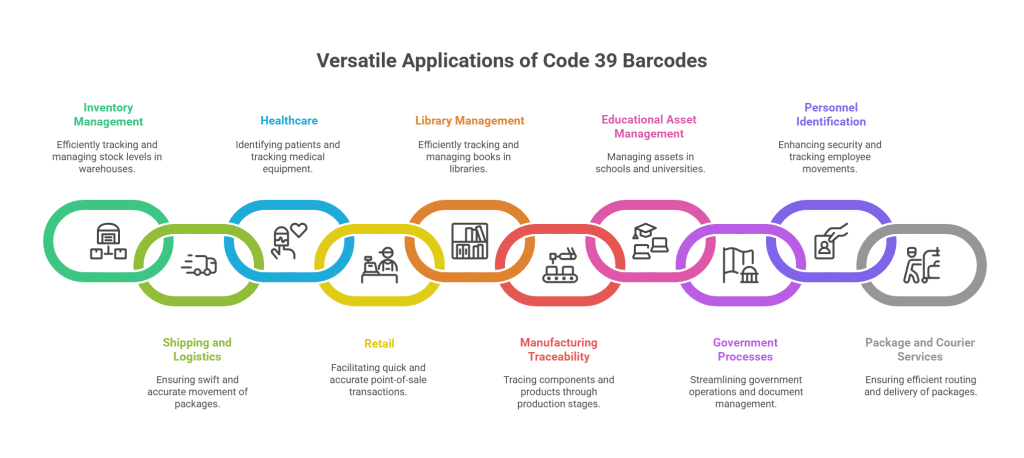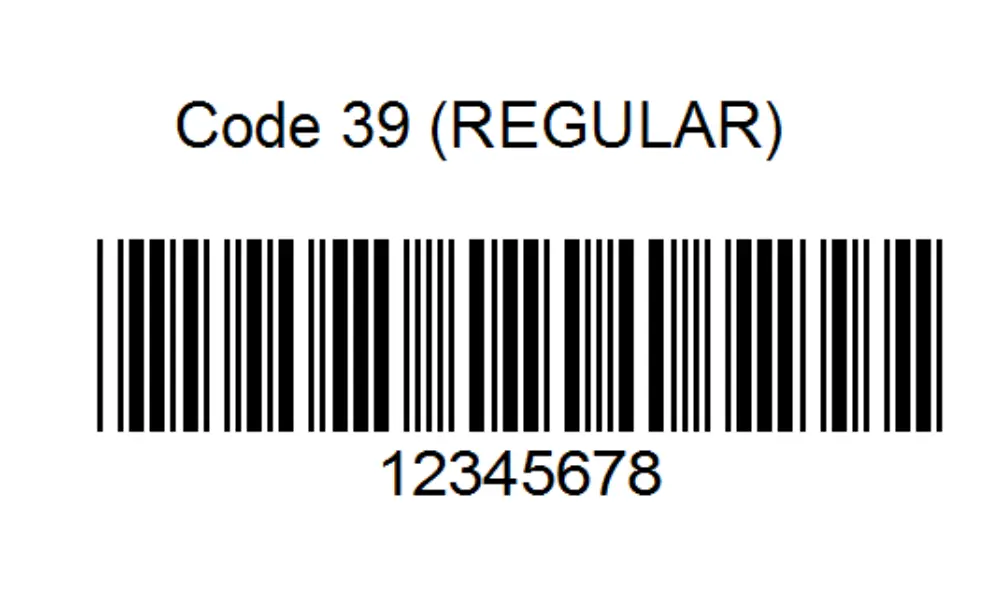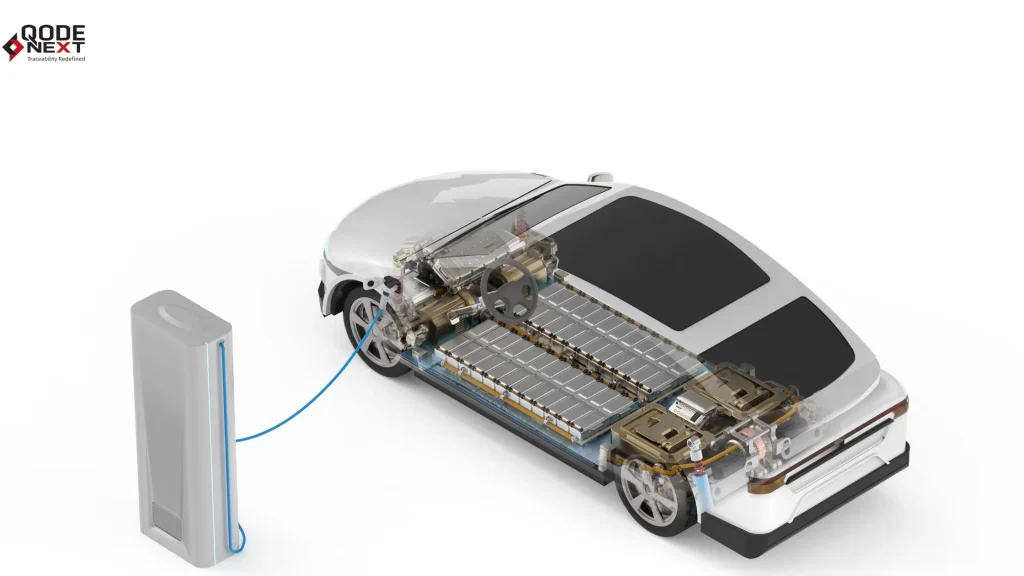Wondering what is a code 39 barcode? Code 39 is the commonly used barcode type for product labels, badges, and inventory applications. It is a pattern of bars, spaces, letters, and symbols used in automotive and electronic industries. It is the easiest alpha-numeric code and is used for character self-checking.
Code 39 is indispensable in multiple industries. However, how to create a code 39 barcode, what are the important components of code 39? We will be covering all the topics related to code 39 in detail.
Let’s begin with understanding the basics of barcodes.

What is a Code 39 barcode? – A Brief Overview
At its essence, a Code 39 barcode sample is a linear barcode symbology that encodes alphanumeric characters. Also known as code 3 of 9 due to its utilization of nine elements, this barcode system employs a set of black and white bars to represent different characters.
What is a Code 39 barcode’s unique identifier?
It is the fact that it doesn’t require a strict character set, making it versatile for encoding a range of data, from numbers and letters to special characters.
Important Components of Code 39:
Understanding the anatomy of a Code 39 barcode is essential for grasping how it functions and how data is encoded. Each element plays a specific role in ensuring that the barcode is readable and secure.
1. Start and Stop Characters
Every Code 39 barcode begins and ends with an asterisk (*), which serves as the start and stop delimiter. These characters help scanners detect where the barcode starts and ends, but they are not part of the actual encoded data.
2. Data Characters
The core data in a Code 39 barcode consists of characters encoded as bars and spaces. Each character is represented by 9 elements (5 bars and 4 spaces). The allowed characters include:
- Uppercase letters (A–Z)
- Numbers (0–9)
- Special characters:
-,., space,$,/,+, and%
This component is critical, as it holds the actual information being communicated by the barcode—making it the central part of what defines Code 39.
3. Check Character
A check character, also called a checksum, may be included at the end of the data (before the final stop character). It is calculated using a modulo 43 algorithm. Though optional, the inclusion of a check character is useful for error detection, ensuring data accuracy and enhancing the overall integrity of the barcode reading process.
How to Create Code 39 Barcode:
Creating a Code 39 barcode is a simple process thanks to the accessibility of online barcode generators and dedicated software. Below is a step-by-step guide to help you produce your own Code 39 barcodes for various business, inventory, or personal uses.
Step-by-Step Procedure
- Choose a Generator
- Select a reputable Code 39 barcode generator online, or install reliable barcode creation software on your computer.
- Many free and paid tools are available; look for features such as output format choices and custom settings for optimal results.
- Input Data
- Enter the information you want to encode into the barcode.
- Remember that Code 39 supports uppercase letters (A–Z), numbers (0–9), and a few symbols (
-,., space,$,/,+,%). - Double-check your data to ensure it fits the allowed character set and avoids unsupported symbols.
- Generate Barcode
- Click the “Generate” or similar button provided by the tool or software.
- The barcode image corresponding to your input data will be created instantly.
- Save or Print
- Save the resulting barcode image in a common format such as PNG, JPG, or PDF.
- Alternatively, print the barcode directly for use on physical products, packaging, or documentation.
- Ensure that the barcode is clear and of suitable size for reliable scanning.
With this process, you can quickly generate Code 39 barcodes tailored to your needs. Once created, these barcodes can be seamlessly integrated into a variety of business processes.
Applications of Code 39 Barcode:

Understanding what a Code 39 barcode is opens the door to its versatile applications.
1) Inventory Management:
Widely used in inventory systems to track products and manage stock levels. These barcodes uniquely identify products, aiding in the efficient tracking and organization of stock. Each item is assigned a distinct Code 39 barcode, simplifying tasks such as stocktaking, restocking, and order fulfillment.
The code 39 barcode scanner is used to scan these barcodes enabling real-time updates to inventory databases, minimizing human errors, and optimizing the overall inventory control process. This streamlined approach enhances operational efficiency, reduces costs, and ensures businesses maintain accurate and up-to-date records of their stock levels.
2) Shipping and Logistics
Code 39 barcodes play a pivotal role in ensuring the swift and accurate movement of packages. These barcodes are commonly employed in shipping labels, providing a unique identifier for each package. This enables logistics personnel to efficiently track and manage shipments throughout the entire transit process.
From warehouses to distribution centers and delivery hubs, Code 39 barcodes streamline operations, reducing the likelihood of errors and ensuring that packages reach their intended destinations with precision and speed.
3) Healthcare
Utilized in healthcare for patient identification and tracking of medical equipment. Patient wristbands often feature Code 39 barcodes containing crucial information, ensuring that healthcare providers can access accurate and up-to-date patient records swiftly. This contributes to improved patient care and reduces the risk of medical errors.
4) Retail:
Commonly found on retail products for quick and accurate point-of-sale transactions.
5) Enhanced Library Management:
Libraries, and repositories of knowledge, have seamlessly integrated Code 39 barcodes into their systems for efficient book tracking and management. Each book is assigned a unique Code 39 barcode, enabling librarians to effortlessly catalog, lend, and retrieve books. This aids in minimizing errors and significantly expedites the tedious process of book inventory.
6) Manufacturing Traceability:
In the intricate web of manufacturing, where components and products undergo multiple stages of production, Code 39 proves to be an invaluable tool. Manufacturers often affix Code 39 barcodes to components, subassemblies, and finished products.
This ensures traceability, making it possible to pinpoint the origin of any defects, streamline production processes, and adhere to quality control standards.
7) Asset Management in Educational Institutions:
Educational institutions, from schools to universities, grapple with the challenge of managing a myriad of assets, ranging from computers to laboratory equipment. Code 39 barcodes simplify this task by offering a systematic approach to asset tracking.
This aids in inventory management, reduces the likelihood of misplaced assets, and facilitates swift identification during audits.
8) Streamlining Government Processes:
Government agencies have embraced the efficiency of Code 39 barcodes in various applications. From driving licenses to official documents, Code 39 plays a pivotal role in creating a standardized and organized system. This not only facilitates quick identification but also enhances the overall efficiency of government processes, reducing the scope for errors.
9) Personnel Identification:
In corporate settings, where access control and personnel identification are paramount, Code 39 barcodes find extensive use. Employee ID cards often feature Code 39 barcodes, enabling secure access to facilities and tracking employee movements. This contributes to enhanced security measures and aids in maintaining a comprehensive record of employee attendance.
10) Package and Courier Services:
The logistics and courier industry relies heavily on accurate and swift tracking systems. Code 39 barcodes are commonly employed in shipping labels, aiding in the smooth flow of packages through various checkpoints. This application ensures that packages are efficiently routed and delivered to the correct destinations, minimizing the chances of errors in transit.
How to Identify Code 39 Barcodes:
Recognizing a Code 39 barcode is relatively easy once you understand its key characteristics. Below are the main indicators to help you identify whether a barcode is using the Code 39 symbology:
1. Look for Asterisks
Each Code 39 barcode begins and ends with an asterisk (*), which functions as the start and stop character. These asterisks are part of the barcode pattern but are typically not shown in the human-readable text beneath the bars.
2. Bar and Space Patterns
Code 39 barcodes use a series of nine elements per character — five bars and four spaces. Out of these nine elements, exactly three are wide and six are narrow. This specific bar-space configuration is unique to Code 39 and helps distinguish it from other barcode types.
3. Decode with a Scanner
To confirm the symbology, use a barcode scanner capable of reading Code 39. When scanned, the device will decode the information and present the original data encoded within the bars. Scanners often display the symbology type, verifying it’s Code 39.
Conclusion
In conclusion, understanding what is a Code 39 barcode and how to create and identify it can prove invaluable in diverse industries. Its simplicity, versatility, and ease of use make it a popular choice for encoding essential information. Whether in retail, healthcare, or logistics, Qodenext will help you implement a seamless barcode solution for your business.
Also read: Barcode Asset Tracking – A Complete Guide in 2023.
Finally, let’s jump to the frequently asked questions for what is a code 39 barcode.
FAQs – What is a Code 39 Barcode?
1. What is the character set of Code 39?
Code 39 doesn’t have a strict character set and can encode alphanumeric characters along with several special characters.
2. Can Code 39 barcodes store large amounts of data?
Code 39 is more suitable for shorter strings of data. For larger amounts of data, other barcode symbologies like Code 128 may be more appropriate.
3. Are Code 39 barcodes widely compatible?
Yes, Code 39 barcodes are supported by most barcode scanners, making them widely compatible across various industries.
4. What is the difference between code 39 and 128?
The main difference between code 39 and code 128 lies in their data storage capacity. Code 39 can store and encode 43 characters while 128 has no character length limit.
5. Why use Code 39 barcode?
Code 39 barcode is primarily used in automotive and electronic industries. It was the first code that was developed with both letters and numbers.
6. What is code 39 on a barcode?
Code 39 is a variable barcode symbology that includes both numbers and letters. There is a fixed length of 43 characters.
7. Is the check character mandatory in Code 39 barcodes?
No, the check character in Code 39 is optional. However, including it can enhance data accuracy by enabling error detection through a modulo 43 checksum calculation, especially in critical applications like healthcare or logistics.
8. Can Code 39 barcodes be used for personal projects?
Absolutely. Code 39 is easy to create and scan, making it ideal for small businesses, libraries, or even personal labeling systems. Free barcode generators and widely available scanners make Code 39 highly accessible.
9. Are Code 39 barcodes suitable for mobile scanning?
Yes, Code 39 barcodes can be scanned using mobile devices equipped with barcode scanning apps. However, the barcode size and clarity must be optimized for accurate scanning, especially under variable lighting conditions.







